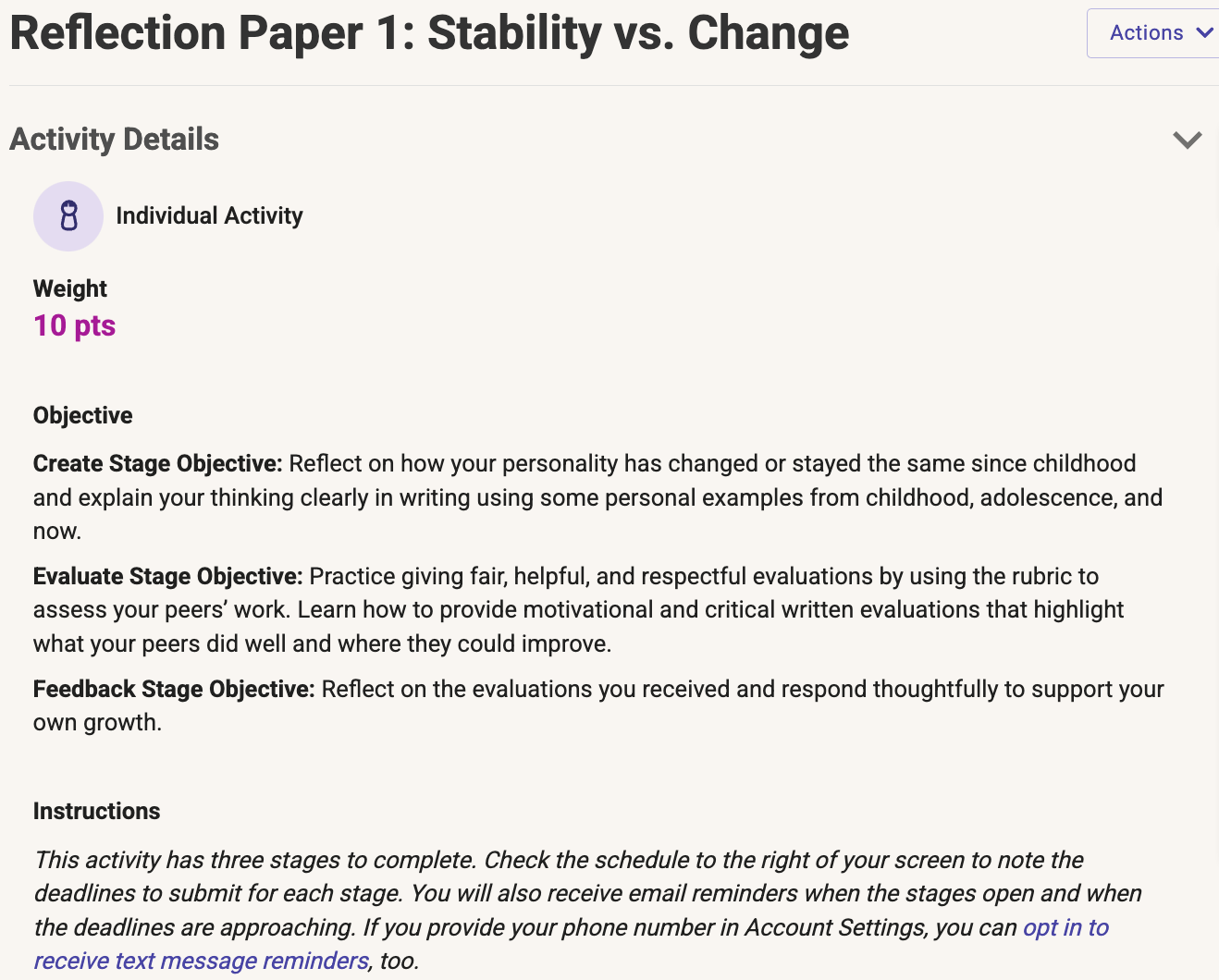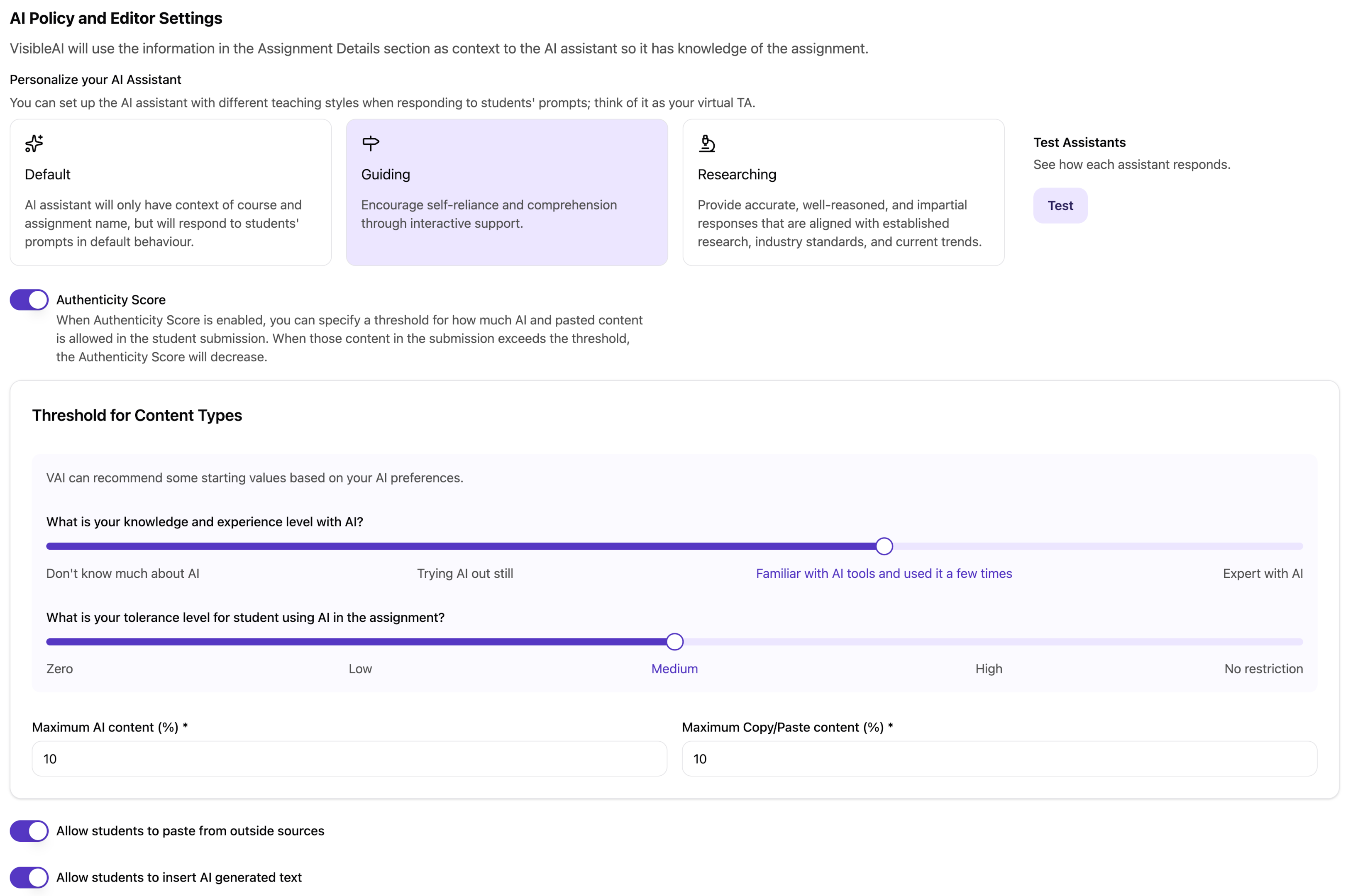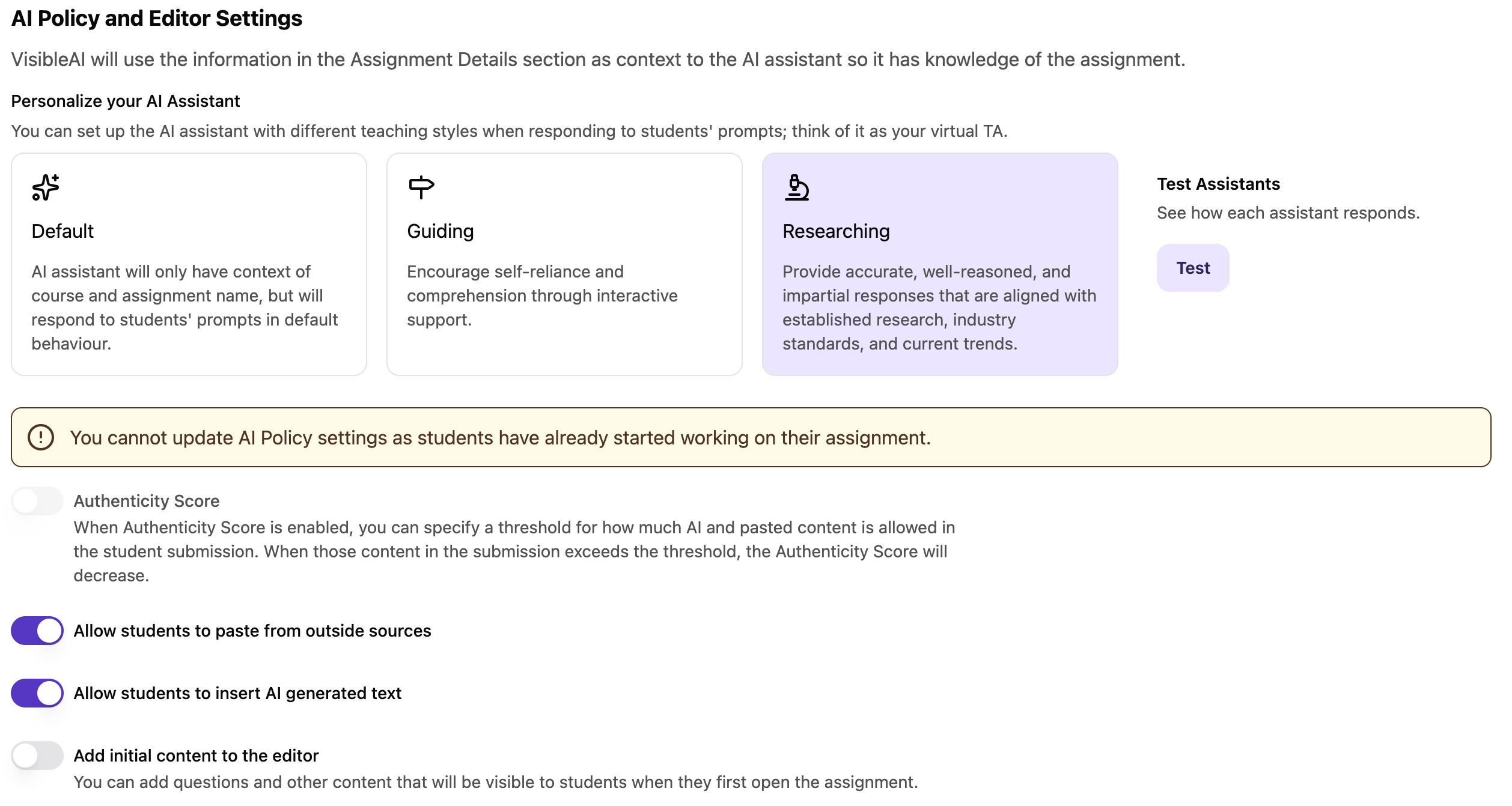Introduction: Shift from Preventing AI Use to Teaching Responsible AI Integration
The academic landscape has fundamentally shifted. With 86% of students using AI for academic assignments in 2024, educators can no longer focus solely on preventing AI use; instead, they must teach responsible integration of AI. This comprehensive guide demonstrates how instructors can enhance their approach to creating assignments by adopting transparency, effective tracking, and pedagogical innovation.
Leading institutions are pioneering this change. Schools like Stanford University and Ohio State announced that they are fully embracing AI, which means faculty and students will be encouraged to incorporate AI in the classroom. An MIT study titled Your Brain on ChatGPT also revealed that students learn best when they are cognitively engaged, emotionally connected and are given the right tools. This study focused on writing assignments. Responsible AI integration not only supports academic success but also positively impacts students' academic journeys and overall lives by saving time, reducing stress, and improving productivity. The key lies not in policing students, but in creating structured environments where AI becomes a powerful learning tool.
Writing-intensive assignments like essays, project reports, case analysis, literature reviews, and reflections present the greatest opportunity for meaningful AI integration.
VisibleAI addresses this challenge by providing complete visibility into the writing process. Unlike traditional AI detection tools that focus on catching violations, VisibleAI emphasizes transparency and educational guidance. The platform helps instructors track student AI use, understand how students interact with AI, and guide them toward responsible integration that enhances rather than replaces learning.
This guide covers policy development, implementation strategies, VisibleAI’s innovative AI modes, and real-world success stories from institutions leading the change in AI-enhanced education.
Building Writing Assignment AI Policy for Responsible Adoption
Importance of setting guidelines for what is allowed and what is not
Effective AI policy transforms potential academic integrity issues into learning opportunities. Rather than blanket bans that drive AI use underground, clear guidelines help students understand how it can enhance their writing process while maintaining academic integrity.
Three Examples of Acceptable AI Use Across Disciplines:
- Literature Analysis (English): Students may use AI to brainstorm initial ideas about themes in a novel, then cite this brainstorming session and develop original analysis through their own critical thinking.
On VisibleAI, students can use the Guiding Mode to brainstorm new ideas. - Case Study Research (Business): AI can help students identify relevant business frameworks or locate academic sources, but the application of these frameworks to specific cases must demonstrate original reasoning.
On VisibleAI, students can use the Default Mode to get information and find sources that they can include in their assignments. - Research Paper Development (Sciences): AI can assist with literature review organization, help explain complex concepts, and support students in organizing and formatting references to meet academic standards, but experimental design, data interpretation, and conclusions must reflect student understanding.
On VisibleAI, students can use the Research Mode to access only academic sources to find data to build their assignments.
Three Examples of Unacceptable AI Use:
- Complete Essay Generation: Having AI write entire sections or full essays without substantial student revision, analysis, or original contribution.
With the Insights tab on VisibleAI, students can always monitor how much AI content is allowed. If they go beyond the acceptable threshold, their authenticity score goes down. - Uncredited AI use: Using AI for significant content generation without proper citation or acknowledgment of AI involvement in the writing process.
Assignments written on VisibleAI make it easy to document all the sources, including external links and books, as well as LLM queries outside of VisibleAI. - Data Fabrication: Using AI to generate fictional research data, statistics, or sources that don’t exist in academic literature.
Download: Build your own AI Policy
Why Assignment AI Monitoring is Critical for Modern Education
Assignment AI monitoring serves as the foundation for responsible AI integration in academic settings. With students engaging with AI assignment writer tools and AI homework helper platforms, institutions must understand how these technologies impact educational outcomes and assessment validity.
Research shows that unmonitored AI use can significantly impact critical thinking development. The writing process becomes mechanical rather than developmental when students bypass the cognitive work that is essential to academic success.
However, proper AI integration through authorship tracking platforms like VisibleAI demonstrates opposite effects. Students who use AI transparently—with full instructor visibility into their AI interactions—show better understanding of source evaluation and enhanced ability to synthesize complex information. The key difference lies in transparency and guided learning rather than secret AI dependence.

Undetected AI use also affects assessment validity and grading fairness. When some students submit AI-generated work while others complete assignments independently, traditional grading criteria become meaningless. Instructors cannot accurately assess student progress or provide appropriate feedback when they don’t understand the level of AI assistance involved in the writing process.
Authorship Tracking vs AI Detection Tools Comparison: Features and Accuracy Rates

VisibleAI provides instructors and students with a full breakdown of the content, sources and AI prompts used to build the assignment. This enables instructors to not only review the student's submission but also go through the process of building the assignment. With VisibleAI, instructors can leave comments within the assignment, on the AI prompts and the citations.
Students submitting their work on VisibleAI know exactly what they are handing in, removing the fear of getting falsely accused of plagiarism.
The fundamental difference lies in approach: while traditional AI detection tools attempt to catch violations after the fact, VisibleAI provides full transparency throughout the writing process. This authorship tracking approach proves more effective for educational outcomes because it focuses on teaching responsible AI use rather than punishment.
Why AI Detection Tools Do Not Work
Traditional AI detection tools rely on pattern recognition and linguistic analysis to identify AI-generated text, but these methods face significant limitations in educational settings. Current detection algorithms analyze sentence structure, vocabulary patterns, and statistical markers that supposedly distinguish human from AI writing, but these markers become increasingly unreliable as AI models advance.
The fundamental problem with detection-based approaches lies in their adversarial nature. As AI models become more sophisticated, they generate text that closely mimics human writing patterns. Students also quickly learn to modify AI output through paraphrasing, editing, or combining multiple AI sources, making detection nearly impossible.
More importantly, detection tools create false positives that can unfairly penalize students. Research shows that AI detection software frequently flags legitimate student work as AI-generated, particularly from non-native English speakers or students with developing writing skills. This leads to academic integrity disputes that damage trust between students and instructors.
VisibleAI addresses these limitations by shifting from detection to transparency. Instead of trying to identify AI-generated text after submission, the platform provides complete visibility into the writing process itself. Instructors can see exactly when and how students interact with AI, what prompts they use, and how they integrate AI responses into their work.
This transparency approach proves far more effective because it focuses on the process rather than punishment. Students learn to use AI responsibly when they know their interactions are visible, and instructors can provide targeted guidance based on actual AI usage patterns rather than algorithmic guesses. This approach also ensures that students receive accurate solutions and explanations, supporting their learning and academic integrity.
Read more: How to tell if text is AI-generated and why detection methods fall short

VisibleAI: 3 AI Policy Modes for Writing Assignments
VisibleAI is an authorship tracking tool that enables instructors and students to have full visibility into the assignment-building process. The goal with VisibleAI is to give instructors transparency into students' use of AI and for learners to build their AI literacy skills. VisibleAI includes a built-in AI assistant that gives students access to ChatGPT-4, Claude, and Gemini, but within educational frameworks designed to enhance learning rather than replace critical thinking.
When instructors set AI policies for their assignments, they can choose between three modes that help students leverage AI responsibly while maintaining 100% transparency in the writing process. Each mode serves different pedagogical goals and assignment types, allowing instructors to match AI use levels with specific objectives.
1. Default Mode


In Default Mode, students can ask prompts to the AI models and receive direct responses. Once students receive answers, they can either insert the text as-is or ask follow-up questions to get more specific information. Students can also request explanations from the AI, allowing them to better understand complex concepts through detailed, step-by-step breakdowns. This mode serves as a powerful tool for improving prompt engineering while helping students understand how AI models work, and identifying potential biases in AI responses.
Default Mode works particularly well for assignments that focus on AI literacy, research methodology, or comparative analysis. Students learn to evaluate AI responses critically, understand the limitations of AI-generated content, and how to fact-check and verify AI sources.
Examples of assignments across disciplines using Default Mode:
- Communication Studies: Students analyze how different AI models respond to the same prompt about social media trends, comparing responses for bias, accuracy, and perspective differences.
- Philosophy: Students use AI to explore different ethical frameworks, then critically evaluate and contrast AI responses with primary philosophical texts.
- Marketing: Students prompt AI to generate marketing campaigns, then analyze the suggestions for cultural sensitivity, target audience appropriateness, and creative originality.
2. Guiding Mode

Guiding Mode represents VisibleAI’s most innovative feature, transforming AI from an answer provider into a collaborative thinking partner. When students submit prompts like “What are the top 5 ways to prioritize mental health?”, the AI model responds with guiding questions: “Can you share 2 solutions you’ve thought about including in your paper?” Based on student responses, the AI continues asking probing questions, encouraging deeper thinking and original analysis.
Guiding Mode is particularly valuable for challenging assignments that demand critical thinking and original analysis. This mode proves especially valuable for complex assignments requiring critical thinking, original research, or creative problem-solving. The AI becomes a Socratic dialogue partner, helping students develop their ideas through questioning rather than providing ready-made answers.
Examples of assignments across disciplines using Guiding Mode:
- Psychology: Students developing proposals receive AI questions about methodology, ethical considerations, and potential limitations, helping them think through the research design comprehensively.
- History: When analyzing historical events, AI guides students to consider multiple perspectives, primary source evidence, and long-term consequences through strategic questioning.
- Engineering: Students tackling design challenges receive AI prompts about constraints, user needs, and sustainability considerations, encouraging systematic problem-solving approaches.
3: Research Mode


Research Mode restricts the AI’s knowledge base to academic papers and scholarly sources, excluding general web content. This creates a controlled learning environment where students can access high-quality academic information through proper research methodologies. This mode enables students to generate well-researched content grounded in credible academic sources.
This mode particularly benefits assignments requiring literature reviews or evidence-based arguments. Students train to work with scholarly sources while understanding how AI can assist in organizing and analyzing academic literature.
Examples of assignments across disciplines using Research Mode:
- Environmental Science: Students exploring climate change impacts access only peer-reviewed studies and scientific reports, ensuring their analysis builds on credible academic evidence.
- Education: Students exploring theories interact with AI that draws exclusively from educational research journals and academic publications.
- Public Health: Students analyzing health policy interventions work with AI responses based solely on published research studies and government health data.
VisibleAI: Success with Writing Assignments with AI at PLNU
Point Loma Nazarene University (PLNU) exemplifies successful AI integration in higher education through their faculty-led approach to ethical AI use. The institution recognized that effective AI adoption requires instructor training and support rather than top-down mandates, leading to innovative implementations across diverse disciplines.
PLNU’s success stems from empowering faculty to experiment with AI while providing structured support through VisibleAI’s transparency features. Professors across departments developed unique approaches to integrating AI into their writing assignments, creating models that other institutions can adapt. The university reported increased student engagement with writing assignments and improved educational outcomes when AI use became transparent and educationally purposeful. Transparent AI use has also contributed to higher grades and academic achievement among students.
The key insight from PLNU’s experience is that successful AI integration requires matching AI assistance modes with specific objectives. Rather than blanket AI policies, professors developed assignment-specific guidelines that helped students understand how AI could enhance their learning without replacing critical thinking. VisibleAI’s tracking capabilities allowed instructors to observe student AI interactions and provide targeted guidance throughout the writing process.

These implementations demonstrate how different AI modes serve distinct pedagogical purposes, allowing instructors to maintain academic rigour while teaching students to use AI tools as learning enhancers rather than shortcuts.
Read the full case study: Point Loma Nazarene’s Approach to Ethical AI Use in the Classroom
FAQs about Writing Assignments with VisibleAI
Q1: How do I handle students who used AI without disclosure?
A1: Our goal with VisibleAI is to teach students how to use AI responsibly rather than policing them. Guide students to cite their work and use the built-in AI assistant. Instructors can leave comments on the document when they are not sure where the students got the information from. Using the History tab on VisibleAI, instructors can see a keystroke-by-keystroke view of how the assignment was built.
Q2: Can VisibleAI integrate with my existing grading workflow?
A2: Yes, VisibleAI integrates seamlessly with major learning management systems, including Canvas, Blackboard, and Moodle. The platform provides detailed analytics that complement traditional grading rubrics and help instructors understand student learning processes. VisibleAI also ensures the confidentiality and security of each student's task and assignment, safeguarding personal data and academic work.
Q3: How do I teach students to use AI ethically for learning?
A3: Start with clear examples of appropriate AI use for your specific assignments. Use VisibleAI’s different modes to structure AI interactions, provide sample AI citations, and regularly discuss how AI assistance differs from original thinking. Model appropriate AI use in your own teaching practices.
Download now: Customizable AI Policy Template
Building an AI-Aware Classroom with VisibleAI
The future of education lies not in resisting AI but in teaching students to use it responsibly and transparently. Successful AI integration in writing assignments requires moving beyond detection-based approaches toward comprehensive visibility and educational guidance. VisibleAI provides the framework for this transformation by offering complete transparency into student AI interactions while supporting learning objectives.
Proactive AI monitoring and education create learning environments where students develop critical thinking skills alongside AI literacy. Rather than viewing AI as a threat to academic integrity, forward-thinking educators recognize these tools as opportunities to enhance research skills, improve writing processes, and prepare students for AI-integrated professional environments.
Check out the rubrics from the Reflection Assignment above:

The evidence from institutions like PLNU demonstrates that transparent AI use improves rather than diminishes educational outcomes. When students understand how to cite AI assistance, engage with AI critically, and use technology to enhance rather than replace their thinking, they develop stronger academic skills and greater confidence in their learning abilities. As students learn to use AI tools transparently and responsibly, they become more confident in their academic abilities.
Implementing VisibleAI in your institution starts with policy development that emphasizes transparency over punishment, followed by faculty training that helps instructors understand AI capabilities and limitations. The platform’s three AI modes provide structured approaches for different assignment types, ensuring that AI assistance aligns with pedagogical goals rather than undermining them.
The time for reactive approaches to student AI use has ended. Institutions that embrace transparent, educationally-focused AI integration will better prepare their students for success in an AI-enhanced world while maintaining the critical thinking and original analysis skills that define quality education.
Ready to transform your approach to writing assignments with AI?
Book a pilot with VisibleAI and discover how transparency and guided AI use can enhance student learning while maintaining academic integrity.
Join the growing community of educators who are leading the change in responsible AI adoption.
Need more ideas? Check out Our E-Book on AI-Assisted Assessments for Your Classroom



